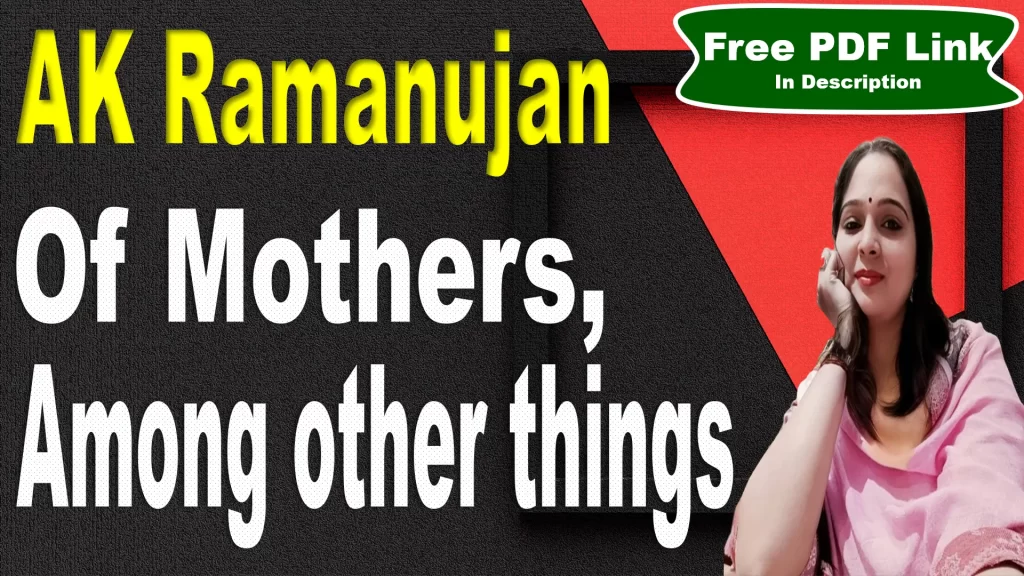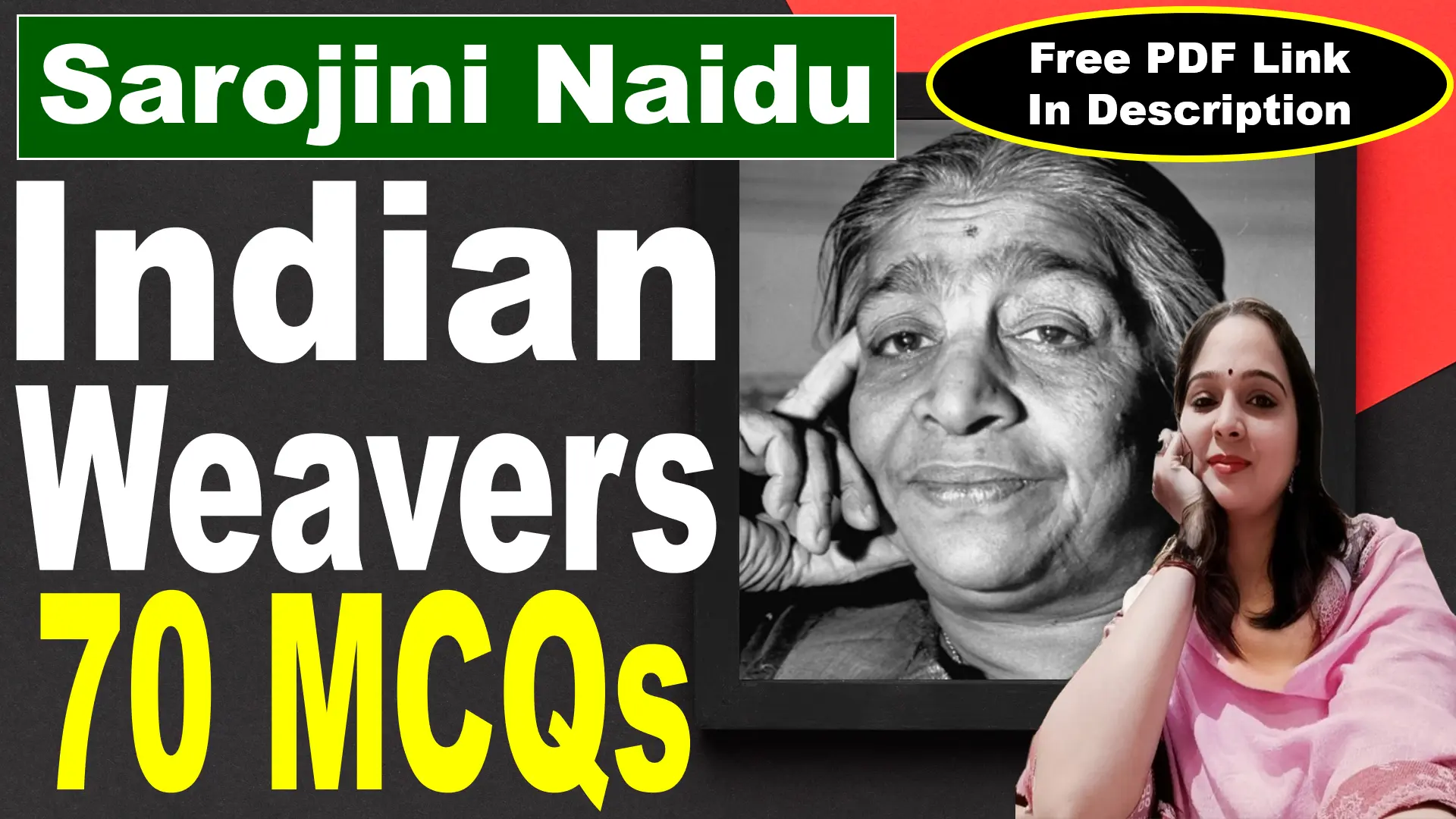
Of Mothers, among other things Analysis
I smell upon this twisted
blackbone tree the silk and white
petal of my mother’s youth.
Reference to Context
These lines are taken from the poem “Of Mothers, among Other Things” by A.K. Ramanujan, included in his collection The Striders (1966). In this poem, the poet reflects on his mother’s life, contrasting her youthful vibrancy with her current frailty, using nature as a metaphor to describe her physical and emotional transformation.
Explanation
In these opening lines, the poet uses the image of a “twisted blackbone tree” to describe his aging mother. The tree’s twisted appearance symbolizes her frail and withered body due to old age. However, the poet also remembers the beauty of her youth, represented by the “silk and white petal.” This contrast between the tree’s dark, rough bark and the delicate, soft petal signifies the passage of time, where the mother’s youthful elegance has faded, but its memory remains vivid in the poet’s mind.
The phrase captures the poet’s feelings of nostalgia, love, and sorrow as he observes the physical decline of the woman who once embodied vitality and grace. It sets the tone for the poem, blending personal memory with natural imagery to convey the bittersweet reality of aging.
Poetic Devices:
Imagery: “Twisted blackbone tree” creates a vivid picture of the mother’s aging body.
“Silk and white petal” evokes the softness and beauty of her youth.
Symbolism: The “tree” symbolizes the mother’s aging body and life’s endurance.
The “petal” symbolizes her youthful beauty and grace.
Contrast: The poet contrasts the “blackbone tree” (old age) with the “silk and white petal” (youth) to emphasize the passage of time.
From her ear-rings three diamonds
splash a handful of needles,
and I see my mother run back
from rain to the crying cradles.
Reference to Context
These lines are from “Of Mothers, among Other Things” by A.K. Ramanujan, where the poet reflects on his mother’s life. Here, he recalls a vivid memory of his mother in her youthful days, portraying her beauty, grace, and dedication as a caregiver. This segment captures her dynamic presence and selfless love during her younger years.
Explanation
The poet describes his mother’s earrings with “three diamonds” that sparkle and reflect light, creating the image of “a handful of needles.” This suggests both her elegance and the sharpness or piercing impact of her youthful beauty and vitality. The dazzling diamonds represent her grace and the richness of her personality.
The poet then shifts to a memory of his mother running through the rain to attend to her crying children (“crying cradles”). This moment reflects her role as a nurturing and selfless mother, prioritizing her children’s needs despite any challenges. The rain adds a sensory detail, symbolizing life’s struggles and fluidity, while her hurried movement conveys her deep maternal instincts and active care.
Poetic Devices:
Imagery: “Three diamonds splash a handful of needles” vividly portrays the sparkle and sharpness of her earrings.
The rain and crying cradles create a dynamic visual of her motherly duties.
Symbolism: The “three diamonds” symbolize beauty and vitality.
The “rain” symbolizes challenges or the passing of time.
“Crying cradles” symbolize her responsibility as a mother.
Alliteration: “Crying cradles” uses repetition of the ‘c’ sound for emphasis and rhythm.
Contrast: The elegance of her earrings contrasts with the urgency of her running through the rain, highlighting her dual roles as a graceful woman and a caring mother.
The rains tack and sew
with broken thread the rags
of the tree-tasselled light.
Reference to Context
These lines are taken from “Of Mothers, among Other Things” by A.K. Ramanujan, where the poet employs vivid natural imagery to explore the passage of time and the transformation of his mother. In this part, he uses rain and light as metaphors to reflect the fleeting nature of life and its imperfections.
Explanation
The poet describes the rain as if it is “tacking and sewing” the fragmented light that filters through the trees. This metaphor gives the rain a creative yet fragile role, as if it is trying to mend or patch together the “rags” of light. However, the “broken thread” suggests that the effort is incomplete or flawed, symbolizing the imperfections and struggles in life.
The “tree-tasselled light” refers to the light passing through the branches of trees, creating a delicate and scattered effect. This imagery reflects the fractured yet beautiful memories of the poet’s mother and the passage of time. The broken thread might also signify the frailty of aging and the inability to restore what is lost, such as youth or vitality.
Poetic Devices:
Imagery: “Rags of the tree-tasselled light” paints a picture of scattered and fragmented light.
“Tack and sew with broken thread” evokes a tactile image of delicate and imperfect mending.
Personification: The rain is personified as sewing with “broken thread,” giving it human-like attributes.
Symbolism: The “broken thread” symbolizes life’s fragility and imperfections.
“Rags of light” signify fragmented beauty and transient moments.
But her hands are a wet eagle’s
two black pink-crinkled feet,
one talon crippled in a garden-
trap set for a mouse. Her sarees
do not cling: they hang, loose
feather of a onetime wing.
Reference to Context
These lines are from “Of Mothers, among Other Things” by A.K. Ramanujan, where the poet reflects on his mother’s aging and the physical toll her life has taken. Through vivid imagery, he contrasts her past strength and grace with her current frailty, capturing the essence of change over time.
Explanation
The poet compares his mother’s hands to a “wet eagle’s… feet.” This metaphor suggests that her hands, once powerful and graceful, are now aged and weakened, resembling the wrinkled and worn talons of an eagle. The description of “one talon crippled” refers to her physical limitations, symbolizing the injuries, struggles, and sacrifices she has endured in her life. The mention of a “garden-trap set for a mouse” adds a layer of tragedy, suggesting an accident or hardship that has permanently affected her.
The poet further observes that her sarees, which once clung tightly to her youthful figure, now hang loosely, like “feathers of a onetime wing.” This simile reinforces the sense of loss—her sarees no longer symbolize her vitality but her diminishing physical strength. The imagery of a bird’s wing alludes to her previous grace and freedom, now reduced to fragility and stillness.
Poetic Devices:
Metaphor: Her hands are compared to “a wet eagle’s… feet,” symbolizing strength diminished by age and struggle.
Sarees are likened to “loose feathers,” reflecting fragility and loss of vitality.
Imagery: “Wet eagle’s… feet” and “garden-trap” evoke vivid pictures of her physical state and hardships.
The sarees hanging loose enhance the visual portrayal of her frailty.
Symbolism: The “eagle” represents her strength and resilience, while its crippled talon signifies the impact of life’s difficulties.
The “garden-trap” symbolizes unforeseen challenges and suffering.
My cold parchment tongue licks bark
in the mouth when I see her four
still sensible fingers slowly flex
to pick a grain of rice from the kitchen floor.
Reference to Context
These lines are from “Of Mothers, among Other Things” by A.K. Ramanujan, where the poet observes his mother in her old age. Through these lines, he captures a poignant moment of her frailty and resilience, reflecting on her physical decline and continued determination despite aging.
Explanation
The poet describes his reaction to seeing his mother using her “four still sensible fingers” to carefully pick up a grain of rice from the kitchen floor. The phrase “cold parchment tongue” conveys his inability to articulate the overwhelming emotions he feels as he watches her. The metaphor suggests dryness, numbness, and perhaps a sense of helplessness or guilt for not being able to express his love or sorrow.
The act of picking up a grain of rice—a small, seemingly insignificant task—is imbued with great meaning. It symbolizes her meticulous care and enduring dignity despite her physical limitations. Her fingers, described as “sensible,” reflect her precision and perseverance, while the “flex” shows her effort to maintain control and capability even in small actions.
This imagery of bending down to retrieve a single grain highlights her fragility yet strength, encapsulating the poet’s deep admiration for her enduring spirit and sorrow at witnessing her decline.
Poetic Devices:
Metaphor: “Cold parchment tongue” symbolizes the poet’s inability to express his emotions and his detachment or struggle with verbalizing his feelings.
“Licks bark in the mouth” metaphorically reflects the dry and harsh emotions he experiences.
Imagery: The description of “four still sensible fingers” creates a vivid picture of her careful, deliberate movements.
The act of picking a grain of rice is a powerful visual of fragility and resilience.
Symbolism: The grain of rice represents life’s small tasks that she continues to fulfill with grace and care.
Her “sensible fingers” symbolize her enduring strength amidst aging.
Alliteration: “Four… fingers flex” subtly reinforces the focus on her physical effort.
Key Points
Author
A.K. Ramanujan (1929–1993), a renowned Indian poet and scholar, is known for his deeply personal and evocative poetry.
His works often explore themes like family, memory, identity, and cultural duality.
This poem is part of his first poetry collection, The Striders (1966).
Structure, Form, and Rhyme Scheme
The poem is composed of five stanzas of four lines each (quatrains).
It is written in free verse, with no fixed rhyme scheme or meter.
The fragmented structure reflects the poet’s scattered memories and emotions, contributing to the poem’s introspective tone.
Speaker
The speaker is the poet himself, reflecting on his mother’s life and his observations of her aging.
It is a deeply personal narrative, blending nostalgia, admiration, and sorrow.
Setting
The poem alternates between:
The past, portraying the mother’s youthful grace and vitality.
The present, where the poet observes her frailty and struggles.
Natural imagery (trees, rain, light) enriches the emotional setting and aligns with the transitions in time.
Theme
Aging and Frailty: The transformation from the mother’s youth to her physical decline.
Maternal Sacrifice: Her dedication and selfless love as a caregiver.
Passage of Time: The inevitability of change and the fleeting nature of beauty and vitality.
Memory and Nostalgia: The poet’s bittersweet recollections of his mother’s life.
Plot
Youthful Grace and Beauty:
The poet begins by reminiscing about his mother’s youth, describing her elegance and vitality through imagery like the “silk and white petal” of her younger days. Her sparkling earrings with “three diamonds” reflect her charm and the sharp impression she left in his memories.
Devoted Mother and Caregiver:
He recalls her selfless love and dedication, visualizing her running through the rain to care for her crying children. This memory captures her active, nurturing role and highlights the physical and emotional energy she devoted to her family.
Aging and Physical Decline:
The poet shifts to the present, portraying his mother’s frailty. He compares her hands to the “wet eagle’s feet,” with one talon crippled, symbolizing her aging body and the hardships she has endured over the years.
Loss of Youthful Vitality:
Her sarees, once clinging to her vibrant form, now hang loosely like “feathers of a onetime wing,” symbolizing the gradual loss of her youthful vigor and the inevitability of aging. This imagery captures the contrast between her past strength and her present fragility.
Resilience in Small Acts:
Despite her physical limitations, her careful act of picking a grain of rice from the floor reflects her enduring dignity, resilience, and meticulous nature. This simple yet powerful moment moves the poet, making him reflect on her transformation and the bittersweet passage of time.
Tone
Nostalgic: Fond memories of the mother’s youth.
Melancholic: Sorrow for her aging and decline.
Reverential: Admiration for her strength and sacrifices.
Style
Imagery: Vivid and sensory-rich descriptions of the mother and her surroundings.
Symbolism: Natural elements (trees, rain, light, and birds) represent her vitality, struggles, and transformation.
Metaphor: Comparisons, such as her hands to an eagle’s feet, emphasize her strength and fragility.
Free Verse: Reflects the organic flow of memory and emotion.
Message
The poem emphasizes the inevitability of aging and the bittersweet reality of seeing loved ones grow old.
It serves as a tribute to maternal strength, love, and sacrifice, celebrating her enduring spirit despite physical decline.
The poet urges us to cherish and honor our loved ones while we still can.
A. K. Ramanujan
Full Name: Attipate Krishnaswami Ramanujan.
Birth: March 16, 1929, in Mysore, India.
Death: July 13, 1993, in Chicago, USA.
Nationality: Indian-American
Background:
Scholar and Academic: A. K. Ramanujan was a distinguished poet, folklorist, and scholar of Indian literature. He worked extensively on South Indian languages and was fluent in English, Kannada, Tamil, and other Indian languages.
Education: He earned his M.A. in English Literature from the University of Mysore and went on to complete a Ph.D. at the University of Chicago, where he later taught.
Career: He became a professor at the University of Chicago, where he taught for many years and contributed significantly to the field of linguistics, folklore, and literary translation.
Literary Contributions:
Poet: A.K. Ramanujan’s poetry is marked by its deep engagement with Indian traditions and themes, along with his modernist approach to language and form. His work reflects his diverse cultural experiences, combining the rich oral traditions of India with the English poetic canon. While he often explored traditional Indian motifs, he did so with a contemporary, introspective twist, examining issues like identity, separation, and cultural conflict.
Poetry Collections: Some of his notable collections include:
The Striders (1966)
Selected Poems (1976)
The Black Hen (1986)
The Collected Poems of A.K. Ramanujan (1995)
Notable Poems:
“A River”: A meditation on the destructive power of nature, contrasting the idealized poetic image of the river with the real-life tragedy caused by its floods.
“Obituary”: A poem that reflects on the themes of loss, death, and the passage of time.
“Small Scale Reflections on a Great House”: A critique of the complexities of modern life and the search for identity.
Translator: He translated classical Tamil and Kannada works, making them accessible to a wider audience. Notable translations include Speaking of Siva and The Interior Landscape: Love Poems from a Classical Tamil Anthology.
Folklorist: His work in folklore included extensive research into oral traditions, storytelling, and the cultural nuances of South Indian and broader Indian folklore.
Themes in His Work:
Cultural Duality: As someone who bridged Eastern and Western traditions, Ramanujan’s work often explores the tension between his Indian heritage and Western influences.
Family and Memory: His poems frequently reflect on personal and family relationships, highlighting the complexities of familial love, loss, and legacy.
Tradition and Modernity: Ramanujan’s writing delves into how traditional beliefs and practices intersect with modern life and personal identity.
Style and Influence:
Unique Voice: Ramanujan’s poetry is marked by its conversational tone, vivid imagery, and use of cultural and personal symbols. His works often shift seamlessly between the specific and the universal.
Impact on Indian English Literature: He played a significant role in shaping modern Indian English literature, bringing a deep, introspective, and culturally rich perspective to the field.
Legacy: His multifaceted contributions as a poet, translator, and scholar left an enduring impact on the study of Indian literature and folklore. His works continue to be studied for their rich portrayal of cultural nuances and deep exploration of human experience.
Awards and Recognition:
Ramanujan received many awards for his work in Indian literature and linguistics. He was given the Padma Shri by the Indian government in 1976 and a MacArthur Fellowship in 1983. In 1988, he gave the Radhakrishnan Memorial Lectures at All Souls College, Oxford. He became a member of the American Academy of Arts and Sciences in 1990. After his death, he was awarded the Sahitya Akademi Award in English in 1999 for his book The Collected Poems (1995).
Word Meaning
| Tough Word | Meaning in English | Meaning in Hindi |
| Twisted | Bent or contorted out of shape | मुड़ा हुआ, टेढ़ा |
| Blackbone tree | A metaphorical description of an old, dark, and gnarled tree | काले रंग की हड्डी जैसा पेड़, बुढ़ापे का प्रतीक |
| White petal | A soft and delicate part of a flower, symbolizing youth | सफेद पंखुड़ी, युवावस्था का प्रतीक |
| Splash | To scatter or sprinkle | छींटे मारना, बिखेरना |
| Crying cradles | Cribs with crying babies | रोते हुए पालने |
| Tack | To stitch temporarily or join with small stitches | हल्के से सिलाई करना, जोड़ना |
| Sew | To stitch or join fabric | सिलाई करना |
| The rags | Torn or worn-out cloth pieces | फटे-पुराने कपड़े |
| Tree-tasselled light | Light filtering through tree leaves, creating patterns | पेड़ों की झिलमिलाती रोशनी |
| Black pink-crinkled feet | Wrinkled, aged feet with dark and pink hues | झुर्रियों वाले काले-गुलाबी पैरों का वर्णन |
| Talon | A claw of a bird of prey | पंजा (चिड़िया का पंजा, जैसे बाज का) |
| Crippled | Disabled or unable to function fully | अपंग, विकलांग |
| Cling | To hold tightly or stick close to | चिपकना, कसकर पकड़ना |
| Wing | A limb used for flying (literal or metaphorical) | पंख |
| Cold parchment tongue | A dry and stiff tongue, symbolizing emotional numbness | ठंडी सूखी जीभ (भावनात्मक सुन्नता का प्रतीक) |
| Licks | To touch or pass over with the tongue | चाटना |
| Bark | The outer covering of a tree | पेड़ की छाल |
| Flex | To bend or move a joint or muscle | मोड़ना या झुकाना |





